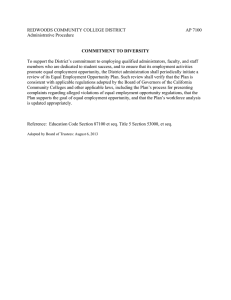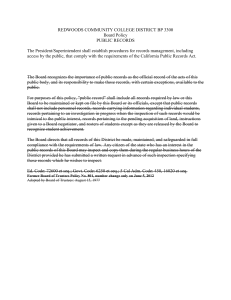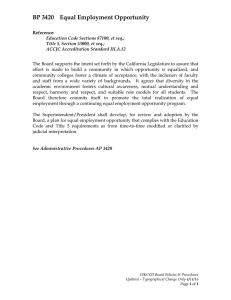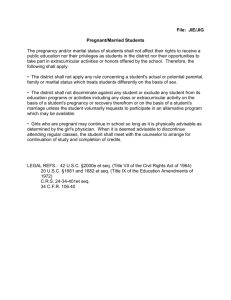Phase space analysis of session cookies
advertisement
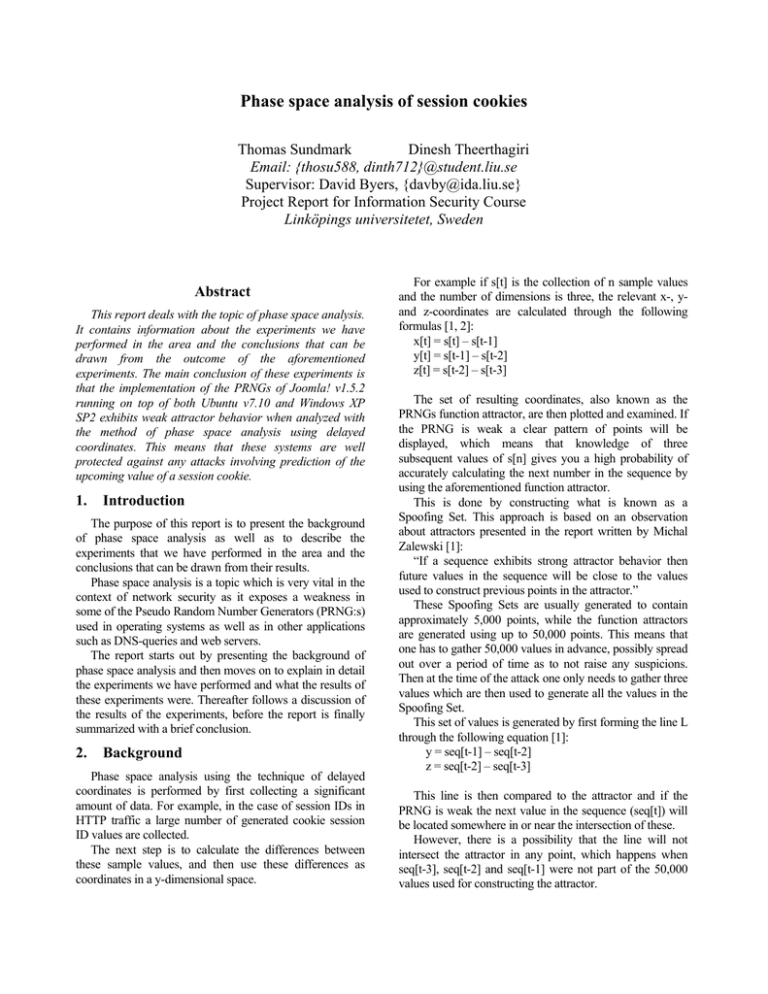
Phase space analysis of session cookies
Thomas Sundmark
Dinesh Theerthagiri
Email: {thosu588, dinth712}@student.liu.se
Supervisor: David Byers, {davby@ida.liu.se}
Project Report for Information Security Course
Linköpings universitetet, Sweden
Abstract
This report deals with the topic of phase space analysis.
It contains information about the experiments we have
performed in the area and the conclusions that can be
drawn from the outcome of the aforementioned
experiments. The main conclusion of these experiments is
that the implementation of the PRNGs of Joomla! v1.5.2
running on top of both Ubuntu v7.10 and Windows XP
SP2 exhibits weak attractor behavior when analyzed with
the method of phase space analysis using delayed
coordinates. This means that these systems are well
protected against any attacks involving prediction of the
upcoming value of a session cookie.
1.
Introduction
The purpose of this report is to present the background
of phase space analysis as well as to describe the
experiments that we have performed in the area and the
conclusions that can be drawn from their results.
Phase space analysis is a topic which is very vital in the
context of network security as it exposes a weakness in
some of the Pseudo Random Number Generators (PRNG:s)
used in operating systems as well as in other applications
such as DNS-queries and web servers.
The report starts out by presenting the background of
phase space analysis and then moves on to explain in detail
the experiments we have performed and what the results of
these experiments were. Thereafter follows a discussion of
the results of the experiments, before the report is finally
summarized with a brief conclusion.
2.
Background
Phase space analysis using the technique of delayed
coordinates is performed by first collecting a significant
amount of data. For example, in the case of session IDs in
HTTP traffic a large number of generated cookie session
ID values are collected.
The next step is to calculate the differences between
these sample values, and then use these differences as
coordinates in a y-dimensional space.
For example if s[t] is the collection of n sample values
and the number of dimensions is three, the relevant x-, yand z-coordinates are calculated through the following
formulas [1, 2]:
x[t] = s[t] – s[t-1]
y[t] = s[t-1] – s[t-2]
z[t] = s[t-2] – s[t-3]
The set of resulting coordinates, also known as the
PRNGs function attractor, are then plotted and examined. If
the PRNG is weak a clear pattern of points will be
displayed, which means that knowledge of three
subsequent values of s[n] gives you a high probability of
accurately calculating the next number in the sequence by
using the aforementioned function attractor.
This is done by constructing what is known as a
Spoofing Set. This approach is based on an observation
about attractors presented in the report written by Michal
Zalewski [1]:
“If a sequence exhibits strong attractor behavior then
future values in the sequence will be close to the values
used to construct previous points in the attractor.”
These Spoofing Sets are usually generated to contain
approximately 5,000 points, while the function attractors
are generated using up to 50,000 points. This means that
one has to gather 50,000 values in advance, possibly spread
out over a period of time as to not raise any suspicions.
Then at the time of the attack one only needs to gather three
values which are then used to generate all the values in the
Spoofing Set.
This set of values is generated by first forming the line L
through the following equation [1]:
y = seq[t-1] – seq[t-2]
z = seq[t-2] – seq[t-3]
This line is then compared to the attractor and if the
PRNG is weak the next value in the sequence (seq[t]) will
be located somewhere in or near the intersection of these.
However, there is a possibility that the line will not
intersect the attractor in any point, which happens when
seq[t-3], seq[t-2] and seq[t-1] were not part of the 50,000
values used for constructing the attractor.
This means that in addition to selecting any intersecting
points for our Spoofing Set we also want to select points in
the attractor that are located “close” to the generated line.
This is performed by selecting all points in the attractor
that are located within a radius R1 of the line and then
using the values of their x-coordinates to generate values
for the Spoofing Set through the following equation: s[t] =
s[t-1] + x[t].
As a last step to make sure we get close to 5,000 points
in the Spoofing Set without selecting too high of a value for
R1 is to take advantage of the fact that the shape of strong
attractors (corresponding to weak PRNGs) tend to fill up
and become more dense as more points are plotted,
implying that the value of x[t] should be relatively close to
the x-value of the points already in our Spoofing Set.
Thus we also add the values x+1, x-1… x+R2, x-R2 to
our Spoofing Set for each value x already present in the set,
where R2 is a value selected to make sure we end up with
approximately 5,000 values.
In conclusion, if the PRNG is weak then one of these
~5,000 values in the Spoofing Set is very likely to
correspond to the next number generated after the three
collected values.
3.
Experiments
This section consists of an explanation of the different
experiments that were performed in the project.
3.1
Ubuntu v7.10
Our first experiment consisted of trying to use phase
space analysis to evaluate the possibility of predicting the
upcoming values of the session-cookies generated by
Joomla! v1.5.2 [3] when running on the 2.2.8 version of the
Apache HTTP server [4] installed on the latest stable
version (7.10) of Ubuntu [5].
The tools used for this experiment were the slightly
modified ‘gathercookies.sh’ script [2] for gathering the
cookie values (see Appendix A for further details) and the
standard text formatting tool Notepad for removing the
irrelevant non-changing parts of the responses.
The remaining values were then fed as input to the
‘hexstring2bigintstring.pl’ script [2] to convert them from a
hexadecimal representation to a more easily handled integer
format before being fed to the ‘seq.pl’ script [2] which
calculated the delayed coordinates corresponding to the
collected cookies.
The coordinates were then saved in a .dat file which was
in turn plotted using gnuplot v4.2.3 [6].
The output from the hexstring2bigintstring.pl script was
also fed into the calprob [1] script which performed the
actual analysis of the number generator by taking as input
the file containing the integer representation of the cookies,
the desired value of R1, the size of the spoofing set as well
as the amount of attempts that should be made.
3.2
Windows XP SP2
In our second experiment we performed the analysis on
the same version of Joomla! [3] and an Apache HTTP
server [4] but we replaced the operating system with
Windows XP SP2 [7].
With the exception of the cookie collection process
we performed the analysis in the same way as above, by
first converting the cookie values to an integer format,
then fed those integers into the seq.pl and calprob scripts
before finally plotting the coordinates using gnuplot [6].
The reason the cookie collection process differed was
because we were unable to get an automated script
working for collecting the cookie values and thus had to
perform the collection manually.
3.3
Custom PRNG
Our third and final experiment involved writing our
own implementation of a PRNG and analyzing it using
the same tools as in the previous experiments.
The purpose of this experiment was to show an
example of a weak PRNG due to the fact that, as our
results below will show, both the initial experiments
yielded results which relate to strong PRNG
implementations.
4.
Results
This section contains the results of the different
experiments performed throughout the project.
4.1
Ubuntu v7.10
Analysing the results with the help of calprob gave the
following results for all attempted values of R1:
Failed attempts: 0/10 (0%)
Average R2: 4998
Average N: 11
Probability: 0%
Plotting the coordinates generated by the first
experiment yielded the image shown in Figure 1 below.
Table 2: Results
See the note below Table 1 in the previous subsection
for an explanation of the different values.
4.3
Custom PRNG
Plotting the coordinates yielded by this experiment
resulted in the following figure:
Figure 1: First experiment
The analysis using the calprob script yielded the
following results regardless of the specified value of R1:
Failed attempts: 0/10 (0%)
Average R2: 4998
Average N: 11
Probability: 0%
Table 1: Results
The failed attempts refer to how many of the attempted
predictions failed to give any output for the given value of
R1, while the probability is based on how close those
outputs came to the actual value given the size of R2.
The average N value corresponds to the average amount
of generated guesses for the given R1 value.
4.2
Windows XP SP2
For the second experiment gnuplot generated the image
shown in Figure 2 below.
Figure 3: Third experiment
The analysis using calprob yielded different results
depending on the choice of R1.
Failed attempts: 423/500 (84%)
Average R2: 2352
Average N: 10
Probability: 15%
Table 3: Results - R1 = 1000
Failed attempts: 209/500 (41%)
Average R2: 1555
Average N: 21
Probability: 58%
Table 4: Results - R1 = 10000
Failed attempts: 20/500 (4%)
Average R2: 468
Average N: 131
Probability: 96%
Table 5: Results - R1 = 100000
An explanation of the values can be found below
Table 1 in the results subsection for the first experiment.
Figure 2: Second experiment
5.
Discussion
The results of the first experiment show that the
combination of Joomla! v1.5.2 [3], Apache v2.2.8 [4] and
Ubuntu v7.10 [5] has a good implementation of its PRNG
for generating cookies.
The second experiment using Windows XP SP2 [7]
instead of Ubuntu v7.10 [5] still shows signs of a correct
implementation of a PRNG for generating the cookies even
though its cloud is slightly smaller, with a scale of 10^32
compared to the scale of 10^39 for the cloud from the first
experiment.
The difference in the scales of the two operating systems
is quite significant, but since the PRNG used by Joomla!
[3] running on Windows XP SP2 [7] still has very good
randomness the difference doesn’t matter much. It would
still take a very large amount of attempts to be able to
accurately predict the value of an upcoming session cookie.
The third experiment on the other hand shows that a
simple PRNG such as the one we wrote using the C++
function rand() and very simple modulo arithmetic, can
easily be broken given a high enough value of R1. It should
also be noted that even with R1 being as low as 1000 there
is still a possibility to correctly predict the upcoming
number in the sequence.
6.
Conclusions
In this report we have given a basic introduction to
phase space analysis using delayed coordinates, provided
details of three experiments that we performed using this
technique and presented the results of the experiments
before rounding off the report with a short discussion of the
results.
The performed experiments showed that both Ubuntu
v7.10 [5] and Windows XP Service Pack 2 [7] have a
strong PRNG implementation when it comes to generating
session cookies for Joomla! v1.5.2 [3] running on an
Apache v.2.2.8 [4] web server.
However, the Ubuntu v7.10 [5] implementation appears
slightly stronger due to its attractor shape being
significantly larger with a scale of 10^39 compared to
10^32 for Windows XP SP 2 [7].
In conclusion one can see that the PRNG
implementations of both systems investigated in the
experiments causes the probability of a successful attack
against them using phase space analysis with delayed
coordinates to be close to zero.
References
[1] M. Zalewski, “Strange Attractors and TCP/IP
Sequence
Number
Analysis”,
http://lcamtuf.coredump.cx/oldtcp/tcpseq.html, 2001.
(Accessed 2008-02-22)
[2] Florian Walther, “How to analyse a Session ID”,
http://www.xs4all.nl/%7Escusi/SessionIDrelease/www/index.html, 2006. (Accessed 2008-02-22)
[3] Joomla!, http://www.joomla.org/ (Accessed 2008-0414)
[4] Apache HTTP Server Project, http://httpd.apache.org/
(Accessed 2008-04-14)
[5] Ubuntu
Home
Page,
(Accessed 2008-04-14)
http://www.ubuntu.com/
[6] Gnuplot
homepage,
(Accessed 2008-04-14)
http://www.gnuplot.info/
[7] Windows
XP:
Home
Page,
http://www.microsoft.com/windows/products/windows
xp/default.mspx (Accessed 2008-04-23)
Appendix A: Tools
Seq.pl
Gathercookies.sh
The ‘gathercookies.sh’ script available for download at
[2] was modified by replacing the ‘grep ASPSESSIONID’
line with ‘grep Set-Cookie:’ to produce the following
script:
#!/bin/sh
# gather.sh
while [ 1 ]
do
echo -e "GET / HTTP/1.0\n\n" |
nc -vv $1 80 | \
grep Set-Cookie:
done
\
Hexstring2bigintstring.pl
The ‘hexstring2bigintstring.pl’ script available for
download at [2] was used to convert the cookies from
hexadecimal numbers to an integer representation.
The ‘seq.pl’ script available for download at [2] was
used to calculate the delayed coordinates for the converted
cookies values given as output from the format conversion
script.
use Math::BigInt;
@seq = ();
@x = @y = @z = ();
while(<>) {
chomp($val = $_);
if (length($val) > 0) {
push(@seq, $val);
}
}
for ($i = 3; $i < $#seq; $i++) {
$o = Math::BigInt->new($seq[$i]);
$m1 = Math::BigInt->new($seq[$i-1]);
$m2 = Math::BigInt->new($seq[$i-2]);
$m3 = Math::BigInt->new($seq[$i-3]);
push(@x, scalar $o->bsub($m1));
push(@y, scalar $m1->bsub($m2));
push(@z, scalar $m2->bsub($m3));
}
use Math::BigInt lib => 'GMP';
while(<>) {
chomp;
$inp = $_;
$inp =~ s/ //g;
$sum = Math::BigInt->new();
$add = Math::BigInt->new();
$mul = Math::BigInt->new();
$exp = Math::BigInt->new('1');
$counter = 0;
if (length($inp) % 2 == 1) {
$inp = "0" . $inp;
}
for ($i = length($inp) - 2; $i >= 0; $i
-= 2) {
$conv = substr($inp, $i, 2);
$char = pack('H2', $conv);
$ord = ord($char);
$add->bzero();
$add->badd($ord);
$mul->bzero();
$mul->badd($add);
if ($counter > 0) {
$exp->bmul('256');
}
$counter += 1;
$mul->bmul($exp);
$sum->badd($mul);
#
print "conv: " . $conv . ", add: " .
$add . ", exp: " . $exp . ", sum: " . $sum .
"\n";
}
print $sum . "\n";
}
for ($i = 0; $i < $#seq; $i++) {
if (defined $x[$i]) {
print $x[$i] . " " . $y[$i] . " " .
$z[$i] . "\n";
}
}
Calprob
The ‘calprob’ script provided by M. Zalewski [1] was
modified slightly to become compatible with the more
recent versions of Bash, yielding the following script:
#!/bin/sh
if [ "$4" = "" ]; then
echo "Usage: $0 datafile.gz r1 fixed_set_size
do_tests"
exit 1
fi
gzip -cd $1 >.tmp3
RADIUS=$2
SIZ=$3
MAX=$4
SUCC=0
SIZE=`grep -c . .tmp3`
FAILED=0
R2SUM=0
NSUM=0
ERSUM=0
NMSUM=0
for i in `seq 1 $MAX`; do
SEQ1=`tail -$((5+$MAX-$i)) .tmp3 | head -1`
SEQ2=`tail -$((4+$MAX-$i)) .tmp3 | head -1`
SEQ3=`tail -$((3+$MAX-$i)) .tmp3 | head -1`
SEQ4=`tail -$((2+$MAX-$i)) .tmp3 | head -1`
echo "$i: Trying $SEQ1 $SEQ2 $SEQ3 (-> $SEQ4)
- r=$RADIUS"
cat .tmp3 | head -$(($SIZE/2)) | ./guess3d
$SEQ1 $SEQ2 $SEQ3 $RADIUS | grep '^> '| awk -F'>
' '{print $2}' | sort -n >.points
QQ=`cat .points`
if [ "$QQ" = "" ]; then
echo " - radius R1 too small? No answers!"
FAILED=$(($FAILED+1))
continue
fi
CNT=`cat .points|wc -c|awk '{print $1}'`
USER2=`./rsort $SIZ <.points 2>/dev/null`
echo " + guess3d gave $CNT answers, rsort
suggests R2 of $USER2..."
GOT=0
AVV=0
for i in $QQ; do
AVV=$(($AVV+1))
ERROR=`echo "if ($i-$SEQ4>0) { $i-$SEQ4 }
else { $SEQ4-$i }" | bc -q`
if [ "$ERROR" -le "$USER2" ]; then
GOT=1
break
fi
done
R2SUM=$(($R2SUM+$USER2))
NSUM=$(($NSUM+$CNT))
if [ "$GOT" = "1" ]; then
SUCC=$(($SUCC+1))
NMSUM=$(($NMSUM+$AVV))
#ERSUM=$(($ERSUM+$ERROR))
echo " -> SUCCESSFUL (difference $ERROR)."
#
exit 0
else
echo " -> Bad guess..."
fi
done
echo
echo "Data file:
$1"
echo "Failed attempts:
$FAILED/$MAX
($(($FAILED*100/$MAX))%)"
echo "Average R2:
$(($R2SUM/($MAX$FAILED)))"
echo "Average N:
$(($NSUM/($MAX$FAILED)))"
if [ "$SUCC" = "0" ]; then
echo "No stats available"
else
echo "Average error:
$(($ERSUM/$SUCC))"
echo "Average correct N: $(($NMSUM/$SUCC))"
fi
echo "Probability:
$(($SUCC*100/$MAX)).`printf '%04d'
$(($SUCC*100000/$MAX % 1000))`%"
rm -f .tmp3 .points .tmp1 .tmp2
guess3d.c
The source code for the ‘guess3d’ program used by the
‘calprob’ script is the following:
#include <vgagl.h>
#include <stdio.h>
#include <stdlib.h>
struct ientry {
unsigned int x,y,z;
};
struct ientry itable[100000];
unsigned int it1[100000];
int cnt;
unsigned int p1,p2,p3;
unsigned int nz,ny;
int gsm,i;
int fr;
unsigned int val;
int radius=0;
unsigned int known[100000];
main(int argc,char* argv[]) {
unsigned int tmp;
FILE* x;
if (argc<4) {
printf("Usage: guess3d seq[t-3] seq[t-2]
seq[t-1] [radius] <datafile\n");
printf("Will guess seq[t].\n");
exit(1);
}
p1=strtoul(argv[1],0,10);
p2=strtoul(argv[2],0,10);
p3=strtoul(argv[3],0,10);
if (argc==5) {
radius=atoi(argv[4]);
} else radius=0;
// printf("%u %u %u\n",p1,p2,p3);
printf("Reading input data...\n");
while (scanf("%u",&tmp)==1) {
it1[cnt++]=tmp;
if (cnt>=100000) break;
}
for (i=3;i<cnt;i++) {
itable[i].x=it1[i]-it1[i-1];
itable[i].y=it1[i-1]-it1[i-2];
itable[i].z=it1[i-2]-it1[i-3];
//
printf(" %u %u
%u\n",itable[i].x,itable[i].y,itable[i].z);
}
ny=p3-p2;
nz=p2-p1;
printf("Reconstructed: x={guess set} y=%u z=%u
(radius=%d)\n",ny,nz,radius);
printf("Choosing candidates (%d
entries)\n",cnt);
x=fopen(".tmp","w+");
for (i=3;i<cnt;i++) {
int j;
unsigned int distance=fabs(itable[i].znz)+fabs(itable[i].y-ny);
if (distance<=radius) {
fprintf(x,"%u
%u\n",distance,p3+itable[i].x);
}
}
fclose(x);
printf("Sorting candidates...\n");
system("cat .tmp | sort -n | uniq -c | sort -n
-r >.tmp2");
x=fopen(".tmp2","r");
while (fscanf(x,"%d %u %u",&fr,&fr,&val)==3)
gsm++;
fclose(x);
if ((gsm>cnt/20) || (gsm<1)) {
printf("Attractor unsuitable [%d].\n",gsm);
exit(1);
}
printf("Guess set (%d elements, from most
probable to least):\n",gsm);
x=fopen(".tmp2","r");
cnt=0;
while (fscanf(x,"%d %u %u",&fr,&fr,&val)==3) {
for (i=0;i<cnt;i++) if (known[i]==val)
break;
if (i==cnt) {
known[i]=val;
printf("> %u\n",val);
cnt++;
}
}
// unlink(".tmp"); unlink(".tmp2");
}
rsort.c
The source code for the ‘rsort’ program used by the
‘calprob’ script is the following:
#include <stdio.h>
#include <unistd.h>
#define MAXPOINTS 10000
unsigned int start,stop,oldstart,oldstop;
int count;
unsigned int points[MAXPOINTS];
int i,j;
unsigned int over;
char buf[1000];
int r;
int dumpanddie;
unsigned int tmp;
main(int argc,char* argv[]) {
if (argc-2) { printf("Usage: guess3d set_size
<data\n"); exit(0); }
r=atoi(argv[1]);
while (scanf("%u",&tmp)==1) {
// Input has to be sorted (sort -n)!
points[count]=tmp;
count++;
}
for (i=0;i<r;i++) {
loopa:
over=0; oldstart=0; oldstop=0;
for (j=0;j<count;j++) {
start=points[j]-i;
if (i>points[j]) start=0;
stop=points[j]+i;
if (stop<start) stop=0xffffffff;
//
printf("Current range: %u-%u (old %u%u).\n",start,stop,oldstart,oldstop);
if (start<=oldstop) {
// Joint ranges.
//
printf(" + Joining ranges!\n");
oldstop=stop;
continue;
}
if (dumpanddie) fprintf(stderr,"Range %u%u.\n",oldstart,oldstop);
over+=(oldstop-oldstart+1);
oldstart=start; oldstop=stop;
}
over+=(oldstop-oldstart+1);
if (dumpanddie) { fprintf(stderr,"Range %u%u.\n",oldstart,oldstop); exit(0); }
//
printf("For i=%d set size is
%u.\n",i,over);
if (over>=r) { printf("%d\n",i);
dumpanddie=1; goto loopa; }
}
}
